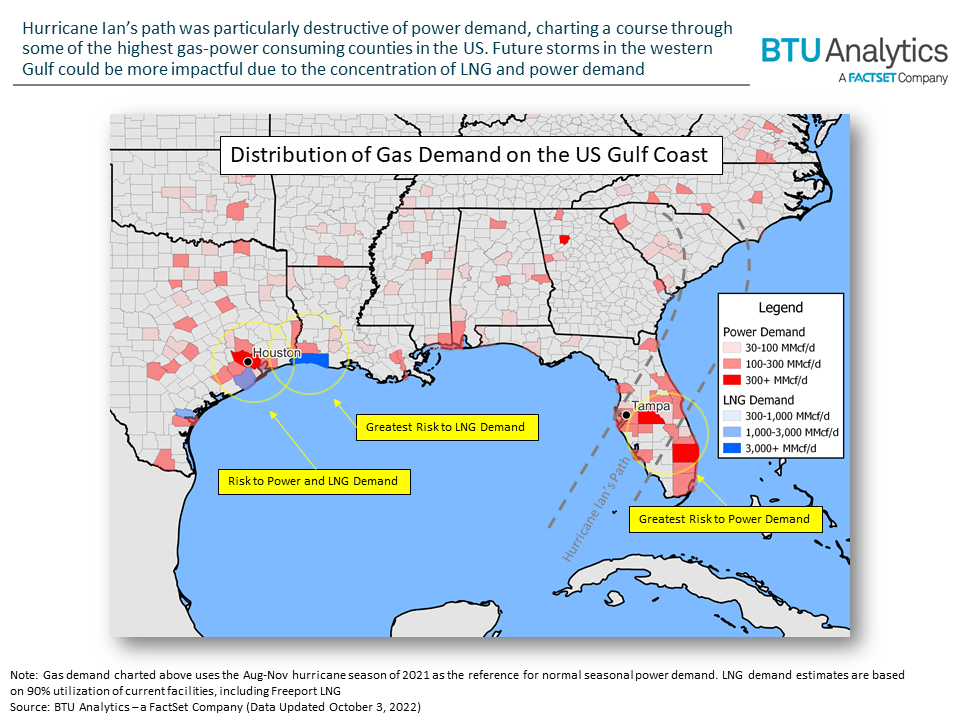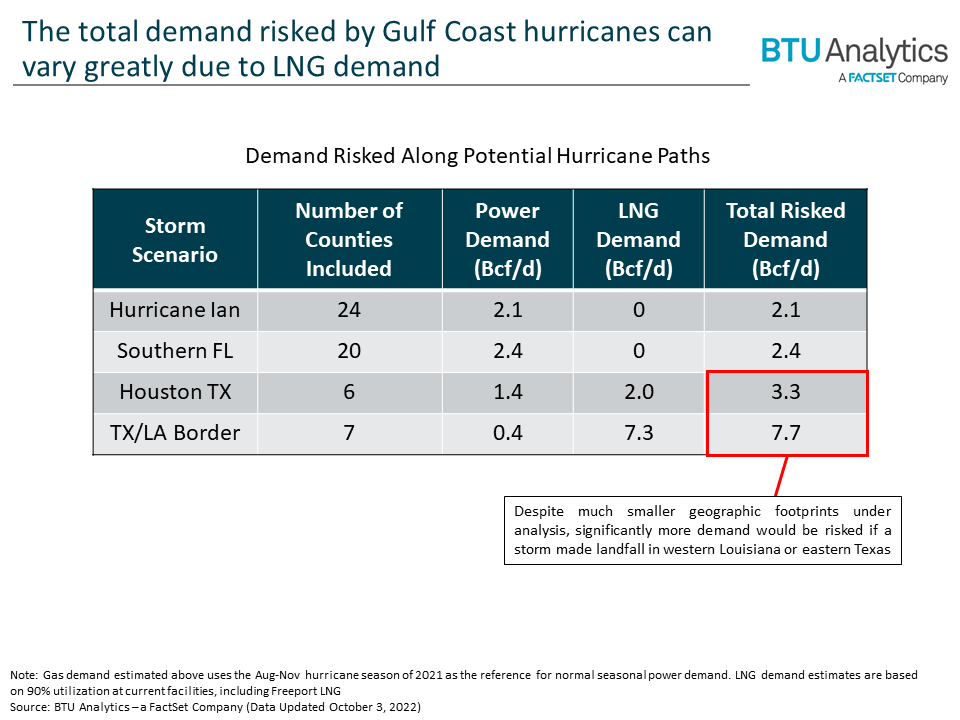Hurricanes have long been considered a supply-side risk for natural gas markets, primarily affecting offshore Gulf of Mexico production. However, as BTU Analytics has previous discussed, the decline of offshore production and rising LNG exports mean that the balance has shifted such that hurricanes now present a larger risk to natural gas demand. Particularly deadly and destructive, Hurricane Ian dramatically illustrated the risk posed to power sector gas demand. In this Energy Market Insight, BTU takes stock of the distribution of gas demand along the Gulf and southern Atlantic Coasts to determine the possible demand-risk presented by future storms.
Making landfall September 29th, Hurricane Ian caused significant damage in Florida and the southern Atlantic Seaboard. More than two million electric customers faced blackouts, mostly in southwestern, central, and northeastern Florida. Correspondingly, natural gas generation in Florida fell by 42% from September 26th to September 30th. Interstate pipeline deliveries to power plants fell by 1.5 Bcf/d, or around 38%. As would be expected, the greatest declines in deliveries occurred at plants in the center of the storm’s path in Polk, Manatee, Lee, and Seminole counties, where a large portion of electric customers suffered blackouts. As utilities continue to make progress in restoring power to major population centers, both generation and pipeline flows have shown signs of recovering in recent days. However, the sustained dent in demand is still likely to contribute to stronger storage builds than would have been expected given 2021-level demand.

While power demand is generally dispersed, Florida has an especially high density of natural gas power plants. BTU ranked all US counties by the amount of gas consumed via power plants during the 2021 hurricane season, finding that ten Florida counties ranked in the top 50. Many of these counties, including Polk, Manatee, Lee, and Hillsborough, were among those most affected by Hurricane Ian.
In fact, as seen in the map below, Hurricane Ian’s path of destruction was uniquely aligned with the I-4 urban corridor of central Florida. While power demand in the southeastern part of the state was only minorly affected, much of the state’s highest gas-consuming counties east of Tampa Bay were positioned squarely in the track of Hurricane Ian and bore the brunt of outages.

BTU used historical gas demand from power plants during the 2021 hurricane season to estimate that a total of 2.1 Bcf/d of demand was at risk along the course of Hurricane Ian. Had the storm tracked further south, causing greater blackouts along the southeastern coast of the state, power-sector risk could have been moderately higher at 2.4 Bcf/d. However, the risk to power demand in Florida pales in comparison to the volumes that would be risked by a storm making landfall in western Louisiana or eastern Texas. As shown above, the Houston area rivals Florida in terms of power demand. Harris county ranks second in the top 50 counties for gas-power and, combined with surrounding counties, 1.4 Bcf/d of power burn would be risked in the event of widespread blackouts. More significant to national demand, both eastern Texas and western Louisiana host substantial LNG infrastructure that would deeply impact the national market if brought offline. In the scenarios outlined below, BTU identifies at least 3.3 Bcf/d of demand at risk in the Houston area and 7.7 Bcf/d at risk along the Texas/Louisiana border, not including the substantial industrial demand also found in these areas. A storm affecting either of these hubs, let alone a storm affecting both, could easily outstrip the market effects of Hurricane Ian.

While Florida rebuilds and markets normalize after Hurricane Ian, BTU anticipates that larger demand-side impacts are possible from future storms, particularly in the western Gulf. The above analysis does not include additional LNG capacity under construction, which is also largely concentrated in western Louisiana and eastern Texas. Those facilities stand to make the above scenarios even more dramatic during coming hurricane seasons.
For more on LNG development, power demand, and other natural gas fundamentals, see BTU’s complete market forecast in the monthly Henry Hub Outlook.









